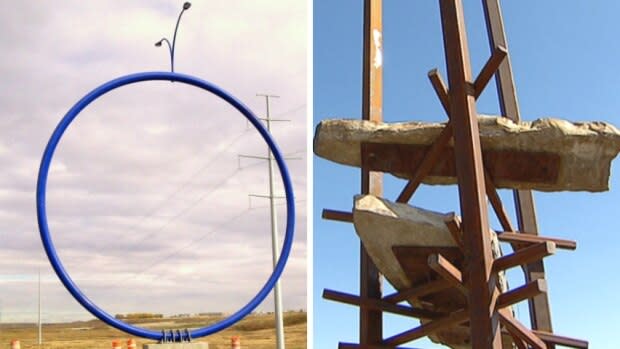Calgary's public art program might move outside city hall
The future of Calgary's public art program may wind up being run outside of city hall.
City council suspended the program in 2017 while it undergoes a review.
That decision came in the wake of public outrage about the Bowfort Towers, a large piece of public art built next to the 16th Avenue/Bowfort Road interchange.
Some members of council were caught off guard by the half a million dollar art project which was created by a New York artist for the city's public art program.
Artists have been invited to public engagement sessions on the future of the program this fall.
They have been told that it's possible council direction and budget cuts will result in the program being managed outside of city hall.
No details are available on what that might look like.
City interested in best practices
The acting manager of arts and culture for the city, Jennifer Thompson, would not speak to any service delivery model the city is looking at.
"What I can say is we're just continuing to look at all best practices and industry models from across the country and nationally and internationally on how we can deliver the best public art program," said Thompson.
City council is expecting a report in the first quarter of 2020 on proposed changes to the public art program.
Council approval would clear the way for the program to resume.
Possible benefits to going outside
No members of council would speak about the prospect of a program that was run outside of the city's bureaucracy.
Sources familiar with the idea though suggest it could potentially save money for the city.
Such a move could broaden the amount of public engagement on projects.
It could also result in more local artists being selected for projects as trade procurement rules that require the city to take proposals from around the world may not be as stringent.

Coun. Shane Keating is one of the council members who supported a review of the public art program, if only to rebuilt public confidence in the program and to possibly even save it.
"I didn't want to see the program outright cancelled but at the same time, I knew it had to change dramatically," said Keating.
He maintains it isn't possible for every piece of public art to be liked.
But he suggests taxpayer-funded public art needs to be accepted by most people in terms of what the city is paying for it and that it be located in places that allow people to appreciate it more.
Both Bowfort Towers and another controversial large piece, Travelling Light, are located next to bridges along busy roadways.
Greater engagement might help
Keating said if more people are consulted about projects, that would allow the city or council members to know a controversy is brewing before construction even starts.
That in itself may not halt a project but it could result in changes that would increase the project's acceptability in the community.
For pieces like Bowfort Towers and Travelling Light, Keating said there were questions in many people's minds whether those projects were art or not.
"That's where we had the failing. There wasn't the ability to [gather] feedback and alter to make it acceptable," he said.
The city's four year budget plan for 2019-2022 includes $3.2 million annually for public art.

